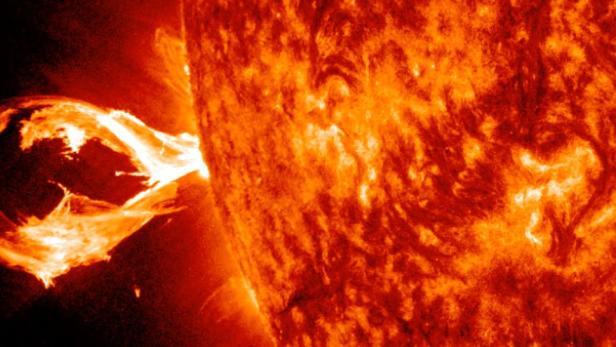
© NASA/SDO/helioviewer.org
Life on Earth could be through a solar flare it was turned on. NASA astrophysicist Vladimir Erpetyan And the pharmacist Kensey Kobayashi the Yokohama National University They showed through many chemical experiments how the sun’s particles collide with the gas in the earth’s atmosphere and as a result amino- And carboxylic acid Form. These two acids are the basic building blocks for the proteins of living organisms.
More generally, science has been investigating the question of how amino acids are formed and how they foster life for decades. The most popular theories date back to the 19th century, where researchers believe life began in some kind of warm little pond. It was a soup of chemicals activated by lightning, heat, and other energy sources. When mixed, they form organic molecules in concentrated amounts.
such as carbon dioxide and molecular nitrogen
This “pond” was created in 1953 in a laboratory Stanley Miller the University of Chicago rebuilt. He created a mixture of methane, ammonia and water And molecular hydrogen. At the time it was assumed that these gases were abundant in the Earth’s atmosphere. Miller ignited an electric spark repeatedly to simulate lightning. After a week, the pool was analyzed and 20 different amino acids were discovered.
“These complex organic molecules could be artificially produced from the primary components of the early Earth’s atmosphere,” says Airapetian. However, this theory has changed a lot in the past 70 years. Because researchers now believe that ammonia (NH3) and methane (CH4) were not as abundant in Earth’s early atmosphere as was first assumed. Instead, they assume the atmosphere is out of reach CO2 And molecular nitrogen Duration. However, these two gases require a great deal of energy to be broken down. They can also form amino acids, but only in small amounts.
new experience
Therefore, instead of lightning, Aryapatyan proposes solar particles as alternative sources of energy. In 2016, he published a study by suggesting that in Earth’s first 100 million years, the sun revolved around 30 percent was weaker. But massive solar flares (“superflares”), which we can only observe every 100 years today, were said to have occurred every 3 to 10 days back then. In superflares, particles are shot out at nearly the speed of light. It regularly collided with our atmosphere, triggering chemical reactions.
To prove their hypothesis, Airapetian and Kobayashi created a gaseous mixture consistent with early Earth’s atmosphere. They mixed carbon dioxide, molecular nitrogen, water and methane. They either bombarded this mixture with photons to simulate solar particles or energized it with a spark to simulate lightning.
Sun particles vs. lightning
The result: if the methane content is over 0.5 percent It was, mixtures that were bombarded with protons, i.e. solar particles, yielded verifiable amino and carboxylic acids. On the other hand, you need spark (lightning) discharges around 15 percent methane to form acids. And then only in small quantities.
This indicates that the solar flare most likely gave rise to life, as the sun’s particles appear to be a more efficient source of energy than lightning.
The study was ImJournal Live published.

